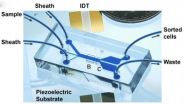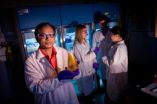(Press-News.org) Vaccine researchers have developed a strategy aimed at generating broadly cross-reactive antibodies against the influenza virus: embrace the unfamiliar.
In recent years, researchers interested in a "universal flu vaccine" identified a region of the viral hemagglutinin protein called the stem or stalk, which doesn't mutate and change as much as other regions and could be the basis for a vaccine that is protective against a variety of flu strains.
In an Emory Vaccine Center study, human volunteers immunized against the avian flu virus H5N1 readily developed antibodies against the stem region of the viral hemagglutinin protein. In contrast, those immunized with standard seasonal trivalent vaccines did not, instead developing most of their antibodies against the more variable head region. H5N1, regarded as a potential pandemic strain, is not currently circulating in the United States and the volunteers had not been exposed to it before.
The results are scheduled for publication in Proceedings of the National Academy of Sciences.
The key to having volunteers' bodies produce antibodies against the stem region seemed to be their immune systems' unfamiliarity with the H5N1 type of virus, says lead author Ali Ellebedy, PhD, postdoctoral fellow in the laboratory of Rafi Ahmed, PhD, director of Emory Vaccine Center.
Collaborators at University of Chicago and Mount Sinai School of Medicine contributed to the study.
"Our previous research led us to hypothesize that immune responses to the stem region are likely to be stronger after exposure to hemagglutinin molecules derived from flu viruses which the human population has been minimally exposed to," Ellebedy says.
Emory Vaccine Center researchers had found that several patients infected with the 2009 H1N1 pandemic flu strain developed broadly cross-reactive antiviral antibodies. In 2009, most younger adults had never been exposed to the H1N1 pandemic strain and thus had no immune cells producing antibodies against it.
But later, after that H1N1 strain started circulating widely in the population, it became part of the standard seasonal trivalent vaccine. When volunteers' immune responses to the seasonal vaccine were analyzed, most of the antibodies they generated reacted to the head region of hemagglutinin.
Immune cells that produce antibodies against the stem region are widely prevalent in humans, but at low levels, the team found. But the standard trivalent seasonal vaccine tends not to amplify them. This led the team to ask whether vaccination with something different enough, such as H5N1, would stimulate production of "anti-stem" antibodies.
"We had already performed a big H5N1 study back in 2008, so we went back and tested our hypothesis with some novel reagents that allowed us to dissect responses that are directed to the head vs. the stem regions," Ellebedy says.
The team analyzed levels of antibody directed against different parts of the hemagglutinin protein in 17 volunteers, before and after H5N1 vaccination. Anti-stem antibody levels rose an average of four-fold after the first H5N1 vaccination. After a booster shot, however, anti-head responses dominated while anti-stem responses were feeble.
The authors conclude:
"Our data indicate that most humans are capable of establishing a humoral immune memory that is specific to the conserved HA stem region…Overall, our data raise the important question of what would be the minimal 'concentration' of antistem antibodies required to provide in vivo protection. Therefore, it will be important in future studies to determine the quantity of HA stem-specific antibodies or memory B cells that would positively correlate with better clinical outcomes against influenza infections."
"Our findings delineate a potential vaccination strategy where H5N1 or H7N9 immunization could be used not only for immunologically priming the population to quickly respond to serious pandemic influenza threats, but also for generating broadly neutralizing antibodies against influenza in humans."
INFORMATION: END
Key to universal flu vaccine: Embrace the unfamiliar
Vaccination against H5N1 flu virus generates broadly reactive antibodies
2014-08-25
ELSE PRESS RELEASES FROM THIS DATE:
SA's Taung Child's skull and brain not human-like in expansion
2014-08-25
The Taung Child, South Africa's premier hominin discovered 90 years ago by Wits University Professor Raymond Dart, never seizes to transform and evolve the search for our collective origins.
By subjecting the skull of the first australopith discovered to the latest technologies in the Wits University Microfocus X-ray Computed Tomography (CT) facility, researchers are now casting doubt on theories that Australopithecus africanus shows the same cranial adaptations found in modern human infants and toddlers – in effect disproving current support for the idea that this early ...
A long childhood feeds the hungry human brain
2014-08-25
EVANSTON, Ill. -- A five-year old's brain is an energy monster. It uses twice as much glucose (the energy that fuels the brain) as that of a full-grown adult, a new study led by Northwestern University anthropologists has found.
The study helps to solve the long-standing mystery of why human children grow so slowly compared with our closest animal relatives.
It shows that energy funneled to the brain dominates the human body's metabolism early in life and is likely the reason why humans grow at a pace more typical of a reptile than a mammal during childhood.
Results ...
Black carbon -- a major climate pollutant -- also linked to cardiovascular health
2014-08-25
Black carbon pollutants from wood smoke are known to trap heat near the earth's surface and warm the climate. A new study led by McGill Professor Jill Baumgartner suggests that black carbon may also increase women's risk of cardiovascular disease.
To investigate the effects of black carbon pollutants on the health of women cooking with traditional wood stoves, Baumgartner, a researcher at McGill's Institute for the Health and Social Policy, measured the daily exposure to different types of air pollutants, including black carbon, in 280 women in China's rural Yunnan province.
Baumgartner ...
Tilted acoustic tweezers separate cells gently
2014-08-25
Precise, gentle and efficient cell separation from a device the size of a cell phone may be possible thanks to tilt-angle standing surface acoustic waves, according to a team of engineers.
"For biological testing we often need to do cell separation before analysis," said Tony Jun Huang, professor of engineering science and mechanics. "But if the separation process affects the integrity of the cells, damages them in any way, the diagnosis often won't work well."
Tilted-angle standing surface acoustic waves can separate cells using very small amounts of energy. Unlike ...
New biomarker highly promising for predicting breast cancer outcomes
2014-08-25
A protein named p66ShcA shows promise as a biomarker to identify breast cancers with poor prognoses, according to research published ahead of print in the journal Molecular and Cellular Biology.
Cancer is deadly in large part due to its ability to metastasize, to travel from one organ or tissue type to another and malignantly sprout anew. The vast majority of cancer deaths are associated with metastasis.
In breast cancer, a process called "epithelial to mesenchymal transition" aids metastasis. Epithelial cells line surfaces which come into contact with the environment, ...
Exposure to toxins makes great granddaughters more susceptible to stress
2014-08-25
Scientists have known that toxic effects of substances known as endocrine disrupting chemicals (EDCs), found in both natural and human-made materials, can pass from one generation to the next, but new research shows that females with ancestral exposure to EDC may show especially adverse reactions to stress.
According to a new study by researchers from The University of Texas at Austin and Washington State University, male and female rats are affected differently by ancestral exposure to a common fungicide, vinclozolin. Female rats whose great grandparents were exposed ...
MU researchers discover protein's ability to inhibit HIV release
2014-08-25
COLUMBIA, Mo. — A family of proteins that promotes virus entry into cells also has the ability to block the release of HIV and other viruses, University of Missouri researchers have found.
"This is a surprising finding that provides new insights into our understanding of not only HIV infection, but also that of Ebola and other viruses," said Shan-Lu Liu, M.D., Ph.D., associate professor in the MU School of Medicine's Department of Molecular Microbiology and Immunology.
The study was recently published in the Proceedings of the National Academy of Sciences. Liu, the ...
Cancer-fighting drugs might also stop malaria early
2014-08-25
DURHAM, N.C. -- Scientists searching for new drugs to fight malaria have identified a number of compounds -- some of which are currently in clinical trials to treat cancer -- that could add to the anti-malarial arsenal.
Duke University assistant professor Emily Derbyshire and colleagues identified more than 30 enzyme-blocking molecules, called protein kinase inhibitors, that curb malaria before symptoms start.
By focusing on treatments that act early, before a person is infected and feels sick, the researchers hope to give malaria –- especially drug-resistant strains ...
Sweet! Glycoconjugates are more than the sum of their sugars
2014-08-25
There's a certain type of biomolecule built like a nano-Christmas tree. Called a glycoconjugate, it's many branches are bedecked with sugary ornaments.
It's those ornaments that get all the glory. That's because, according to conventional wisdom, the glycoconjugate's lowly "tree" basically holds the sugars in place as they do the important work of reacting with other molecules.
Now a chemist at Michigan Technological University has discovered that the tree itself—called the scaffold—is a good deal more than a simple prop.
"We had always thought that all the biological ...
Doctors miss opportunities to offer flu shots
2014-08-25
Doctors should make a point of offering a flu vaccine to their patients. A simple reminder could considerably reduce the number of racial and ethnic minorities who currently do not vaccinate themselves against this common contagious respiratory illness. This recommendation is based on research led by Jürgen Maurer of the University of Lausanne in Switzerland and the RAND Corporation in the US. Their findings¹ are published in the Journal of General Internal Medicine², published by Springer.
Up to 50,000 Americans die annually of influenza and related diseases such as ...
LAST 30 PRESS RELEASES:
Interaction of climate change and human activity and its impact on plant diversity in Qinghai-Tibet plateau
From addressing uncertainty to national strategy: an interpretation of Professor Lim Siong Guan’s views
Clinical trials on AI language model use in digestive healthcare
Scientists improve robotic visual–inertial trajectory localization accuracy using cross-modal interaction and selection techniques
Correlation between cancer cachexia and immune-related adverse events in HCC
Human adipose tissue: a new source for functional organoids
Metro lines double as freight highways during off-peak hours, Beijing study shows
Biomedical functions and applications of nanomaterials in tumor diagnosis and treatment: perspectives from ophthalmic oncology
3D imaging unveils how passivation improves perovskite solar cell performance
Enriching framework Al sites in 8-membered rings of Cu-SSZ-39 zeolite to enhance low-temperature ammonia selective catalytic reduction performance
AI-powered RNA drug development: a new frontier in therapeutics
Decoupling the HOR enhancement on PtRu: Dynamically matching interfacial water to reaction coordinates
Sulfur isn’t poisonous when it synergistically acts with phosphine in olefins hydroformylation
URI researchers uncover molecular mechanisms behind speciation in corals
Chitin based carbon aerogel offers a cleaner way to store thermal energy
Tracing hidden sources of nitrate pollution in rapidly changing rural urban landscapes
Viruses on plastic pollution may quietly accelerate the spread of antibiotic resistance
Three UH Rainbow Babies & Children’s faculty elected to prestigious American Pediatric Society
Tunnel resilience models unveiled to aid post-earthquake recovery
Satellite communication systems: the future of 5G/6G connectivity
Space computing power networks: a new frontier for satellite technologies
Experiments advance potential of protein that makes hydrogen sulfide as a therapeutic target for Alzheimer’s disease
Examining private equity’s role in fertility care
Current Molecular Pharmacology achieves a landmark: real-time CiteScore advances to 7.2
Skeletal muscle epigenetic clocks developed using postmortem tissue from an Asian population
Estimating unemployment rates with social media data
Climate policies can backfire by eroding “green” values, study finds
Too much screen time too soon? A*STAR study links infant screen exposure to brain changes and teen anxiety
Global psychiatry mourns Professor Dan Stein, visionary who transformed mental health science across Africa and beyond
KIST develops eco-friendly palladium recovery technology to safeguard resource security
[Press-News.org] Key to universal flu vaccine: Embrace the unfamiliarVaccination against H5N1 flu virus generates broadly reactive antibodies




